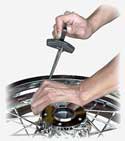|
It’s no accident that Bondhus is recognized the world over for
quality tools. Bondhus invented the ball-end, and continues to produce
products unmatched in quality, machining, and durability, even in the
smallest ball sizes. Engineering and manufacturing skills, coupled with
a sales and support staff second to none, has made the name Bondhus
synonymous with quality.
|
|
Ballend Considerations:
- Ballends provide very fast insertion into screw heads, even from an
angle, or when working in the blind.
- Screw-holding technology, such as Bondhus ProHold™ tip, is a dramatic
improvement in the utility of ballend tools.
 - The concept by which ballends slide into a screw head is known as
funnel insertion. Basically, it means that the sides of the ballend
direct (funnel) it into place.
- A ballend can be used in a power driver, and even at 500 RPM, funnel
insertion will radially twist the ball into position and seat it in the
screw head.
- Quality ballends seat to full depth in a screw, and
are no more prone to stripping than a straight blade.
- A straight hex blade may have greater torque capacity than a ballend,
but a ballend is far more efficient.
- A high quality ballend is capable of generating the recommended
seating torque for most screws, but care should still be exercised to
not over-torque a ballend.
- Due to its many advantages, a ballend is a tremendous timesaver.
- Star ballends wear more rapidly than hex ballends, due to the star
having less contact surface.
- Operators can feel when a straight blade begins to ‘yield’,
but ballends break without exhibiting any telltale warning
signs.
-
 Using ballends with a torque wrench or torque handle,
reduces the chance of breakage and greatly extends the useful
bit life. Using ballends with a torque wrench or torque handle,
reduces the chance of breakage and greatly extends the useful
bit life.
- A good rule of thumb is to set the torque level to about 20%
less than the capacity of the ballend.
- The maximum torque capacity, and the allowable working angle
permitted by the ball are major factors to consider when
evaluating a ballend. Increasing working angle decreases torque
capacity, and increasing strength increases neck size, and thus
decreases working angle.
-
 As maximum allowable angle increases, neck size decreases,
and strength also decreases. By contrast, increasing the
strength of a ball-end tool requires a corresponding increase in
neck size and decrease in maximum allowable angle. As maximum allowable angle increases, neck size decreases,
and strength also decreases. By contrast, increasing the
strength of a ball-end tool requires a corresponding increase in
neck size and decrease in maximum allowable angle.
- Designing the perfect ball-end tool means choosing the ideal
balance between strength and allowable angle.
|
Bondhus Advantages:
- Protanium® Steel is used in the manufacturing of all Bondhus tools.
- Protanium® Steel achieves levels of hardness, ductility, and wear
unmatched in the industry.
- ProGuard™ dry surface finish is standard on all unplated Bondhus
tools.
- Bondhus has the most comprehensive lineup of handles, blades, bits,
and packaging options available.
- Exceptionally high quality machining means:
- Tools fit better, so they last longer.
- Engagement in screw heads is positive and stable.
- Fastener heads exhibit less wear.
- Stripping and breaking is noticeably reduced.
- All Bondhus Balldriver® tools are carefully matched with handles of consistent torque
capacity. Bondhus does not manufacture tools with handles capable of
over-torqueing their blades!
- Bondhus ballends provide very fast insertion into screw heads, even from an
angle or when working in the blind.
- Balldriver® tools with or without ProHold™ tips, are available in hex,
star, and square tips.
|

